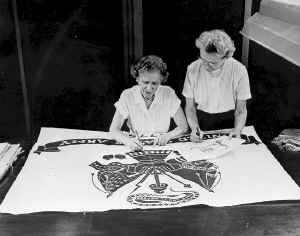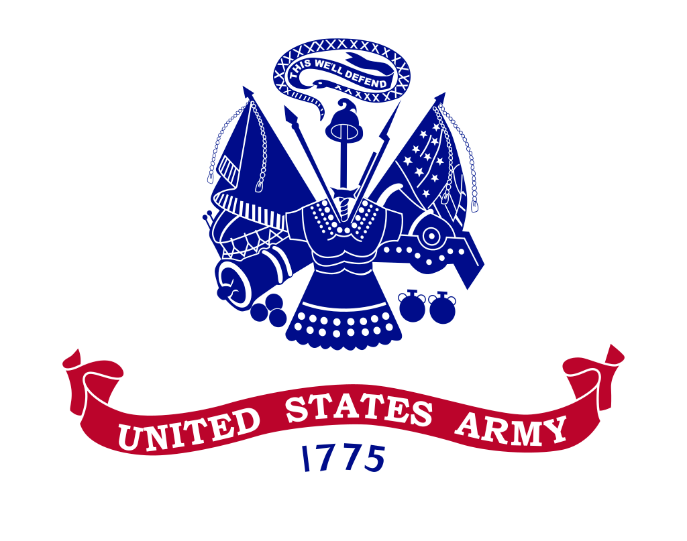Short History of Army Flag

Fact Sheet
Office of The Quartermaster General
Washington D.C.
1 June 1957
The United States Army Flag was officially adopted by order of President Dwight D. Eisenhower through Executive Order No. 10670, on June12, 1956.
The newly adopted flag was presented by Vice President Richard Nixon to Secretary of the Army Wilber M. Brucker in a ceremony at the Capitol, Washington DC, on June 13, 1956. On the following day, June 14, Flag Day and also the 18lst anniversary of the establishment of the Army the United States Army Flag was unfurled at Independence Hall, Philadelphia, in connection with public a public address by Secretary Brucker.
The United States Army came into being by action of the Continental Congress on June 14, 1775, and two years later, on June 14, 1777, the Continental Congress officially adopted the Stars and Stripes as the Flag of the United States.
Although various elements of the Army, from groups and corps down to separate battalions, have their own colors and distinguishing flags, none has previously served for the Army as a whole. The new United States Army flag is designed to meet the need for a flag which will represent the entire Army on appropriate occasions.
The Army flag is made up in the National colors red, white, and blue, with a yellow fringe. It is the standard size for colors: 4 feet, 4 inches hoist and 5 feet 6 inches fly. It bears 145 streamers (Note: as of 2022 190 streamers) of ribbons representing the campaigns in which the Army has participated since its inception.

The flag is made of white silk, upon which is embroidered in blue, a replica of the official seal of the War Office. Beneath the seal is a broad scarlet scroll bearing the inscription in white letters, “United States Army”. Beneath the scroll blue Arabic numerals, is “1775”, the year in which the Army was created with the appointment of General George Washington as Commander-in-Chief.
The original War Office seal, constituting the central design of the Army Flag was authorized by the Continental Congress on May 8, l779. The seal is thus described:
“A cannon in front of a drum with two drumsticks; below the cannon three cannon balls. A mortar on a trunion and below the mortar two powder flasks. In the center a Roman breastplate over a jupon (leather jacket). Above the breastplate rises a plain sword with the pommel and guard supporting a Phrygin cap between an esponton (pike) and an organizational color on one side and a musket with a fixed bayonet and and the National color on the other side. Above is a rattlesnake holding in its mouth a scroll inscribed, ‘This We’ll Defend’ “.
The cannon balls and powder flasks are of the Revolutionary War type. The Phrygian cap is the traditional symbol of liberty.
The War Office was at first officially known as “A Board of War and Ordnance.” The third such Board appointed by Congress was succeeded on February 7, 1781, by a Secretary at War, which position was filled with the appointment of Major General Benjamin Lincoln on October 30 of the same year. Henry Knox was elected Secretary at War by Congress on March 8, 1785. He served through the period of the Articles of Confederation until the office was established as an executive department under the United States Constitution. He thereby became the first Secretary of War.
The Department of War was created by Congress on August 17, 1789, and and so remained until it was retitled Department of Army under the Unification Act of July 26, l947. Since the beginning, however, the seal of the War Office has continued to serve the Department of War and Department of the Army.
The campaign streamers are attached below the spearhead of the flagstaff. Each steamer is 2 3/4 inches in width and 4 feet in length. They are designed in the colors of the respective campaign ribbons and are embroidered with the designations of the campaigns and the years in which they took place. The following colors are employed in design of the streamers representing major campaigns:
Revolutionary War:
War of 1812:
Mexican War:
Civil War:
Indian Wars:
War with Spain:
China Relief Expedition:
Philippine Insurrection:
World War I:
World War II:
scarlet with a white stripe
scarlet with two white stripes
green with one white stripe
blue and grey, equally divided
scarlet with two black stripes
yellow with two blue stripes
yellow with blue edges
blue with two red stripes
double rainbow
American theater — blue with two groupings of white, black, red, and white stripes; with blue, white, and red in the center.
European-African-Middle Eastern Theater — green and brown with two stripe groupings, one of green, white, red, and the other of white, black, and white stripes; with blue, white, and red stripes in the center.
Asiatic-Pacific Theater — orange with two white, red, and white stripe groupings; with blue, white, and red stripes in the center
Korean Service: Light blue bordered on each side with white; with a white center stripe.
The Army flag was designed by the Heraldic Branch, Office of Research and Engineering, Office of The Quartermaster General. Research on background material was begun in July 1955, when a requirement for a United States Army flag was indicated by the Secretary of the Army. Several tentative designs were developed and from among these the design as adopted was selected by Secretary of the War Brucker.
The flag presented by Vice President Nixon to Secretary Brucker was hand embroidered by expert women needle workers at the Philadelphia Quartermaster Depot. Other hand embroidered flags were presented to President Eisenhower; the Chief Of Staff, U.S. Army; and for display in the Pentagon building corridor near the entrance to the office of the Secretary of the Army.
A limited number of additional flags have been made at the Philadelphia Depot. These additional flags however have the design appliqued rather than embroidered. The appliqued flags, without campaign streamers were assigned to the various Army headquarters, service schools, and other locations designated by the Secretary of the Army.
(Note: For a current list and description of the 190 streamers authorized to adorn the U.S. Army Flag, visit the Center for Military History.)
